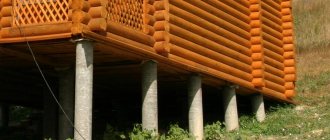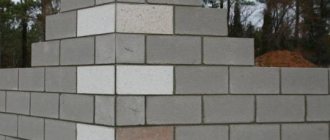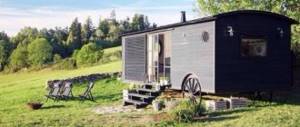Foam blocks: features and characteristics
Traditionally, a bathhouse is built from wood materials, such as timber, logs, etc. They are good for everyone, except perhaps the need for constant maintenance, since the wood begins to rot quite quickly under the influence of dampness. Without some care, a wooden bathhouse will very quickly lose its original appearance.
Foam block bath projects
But recently, bathhouses are often built from foam blocks. This material is an excellent alternative to traditional wood, as it has a lot of advantages and in some cases even surpasses wood in its characteristics. A foam block is a block of a certain size made from foam concrete or cellular concrete . It has not been a novelty on the construction market for a long time, but previously it was used much less frequently than now, due to the fact that its main disadvantage - hygroscopicity due to high porosity - has been overcome.
Foam block
However, the presence of porosity is the main feature of such materials. Thanks to it, foam blocks have an excellent level of thermal insulation, are able to perfectly retain heat in any structure, and are not too heavy materials. The pores inside the block can have different sizes and are located randomly throughout its entire interior.
Important! Due to the presence of pores, blocks absorb water very strongly. In the summer this is not scary, but in the winter the water, freezing, expands and can damage the blocks. That is why foam block buildings, and especially bathhouses, must be carefully insulated from water. Moreover, waterproofing work is carried out both inside and outside the building.
Foam concrete - production process
Bathhouse made of expanded clay concrete blocks: pros and cons
Expanded clay blocks are made from granulated clay, sand and cement, which are subjected to vibration pressing. They are many times larger in size than bricks, so the assembly of buildings is much faster. Blocks can be dense or hollow.
Expanded clay concrete blocks are a high-quality material that is actively used for the construction of housing and baths.
Advantages of a bath made of expanded clay block:
- environmental friendliness. When creating the material, sand, cement, expanded clay and water are used. There are no chemical additives in the composition of expanded clay concrete blocks;
- low thermal conductivity. Thanks to this property, there is no need to heavily insulate the walls; expanded clay concrete retains heat well in the room;
- fire resistance. Wood is a highly flammable material, but blocks do not burn;
- chemical inertness. Expanded clay concrete is not susceptible to fungus, mold and other harmful microorganisms;
- frost resistance. The material is resistant to low temperatures;
- strength and resistance to high loads;
- light weight. Thanks to this indicator, you can save on the foundation, since there is no need to make a reinforced foundation;
- ease of installation. Making a bathhouse from expanded clay blocks with your own hands is not difficult, so there is no need to contact builders, you can build the building yourself;
- efficiency. The material is inexpensive, so construction will be quite inexpensive.
Expanded clay concrete, unlike wood, does not rot or burn. If we compare it with foam concrete, then expanded clay concrete also has important advantages: it does not absorb moisture and has a fairly low cost. Thanks to these properties, bathhouses made of expanded clay concrete can be built in any region of Russia, including the northern ones.
But like any other material, expanded clay concrete also has disadvantages. The main one is its unpresentable appearance. A bathhouse made of expanded clay blocks will need external finishing, which leads to additional expenses.
Since ancient times, bathhouses have traditionally been built from wood. Many choose to continue this centuries-old custom. If you are worried that a bathhouse made of expanded clay concrete will not be so cozy, then you don’t have to worry: in any case, you will be doing the interior decoration, for which wooden lining is usually used, so it will not be difficult for you to create the necessary atmosphere in the bathhouse.
If you look at the reviews about a sauna made of expanded clay blocks, you can see that in general people are satisfied with the chosen material. Of course, it has its drawbacks, in particular, it requires additional waterproofing, and is also not suitable for the construction of multi-story buildings. But if you choose expanded clay concrete to build a simple bathhouse, the material will be an excellent and profitable solution.
Types of foam blocks
Foam blocks, depending on the manufacturing technology, may have different properties and some differences in appearance. The table below provides a description of the main varieties of this material.
Foam blocks are different
Table. Types of foam blocks.
| View | Description |
| Aerated concrete | This version of foam blocks is made from cement with the addition of aluminum powder. During the chemical reaction that occurs due to the addition of powder, pores are formed in the mixture. The future block is placed in an autoclave, where great pressure is applied to it, and the concrete hardens. The sizes of such blocks may differ from each other, this is due to the peculiarities of their manufacture. But deviations from the standards (average block dimensions 30x25x60 cm, weight - 30 kg) are, as a rule, insignificant, which makes it possible to obtain a minimal seam when laying blocks. Also, this version of foam blocks is called gas block or autoclaved foam concrete. The material is quite often used for the construction of baths and other structures. It is lightweight, conducts heat well, does not burn, and is not afraid of frost. It is also a fairly economical material and easy to process - it can be cut with a hacksaw. |
| Silica concrete | This type of block has a white color due to the addition of lime to the composition from which it is made. It is necessary to bind the mixture. This version of foam blocks has the highest hygroscopicity. There are a lot of pores in the structure of each block - 50% of the total volume. Due to the presence of a large number of voids, the blocks are very light and can be used for construction on light foundations. This material has excellent heat and sound insulation properties, so a bathhouse made from it will keep warm for a long time. |
| Foam concrete | This version of the foam block is produced in almost the same way as conventional aerated concrete, but without the effects of temperature. Concrete hardens naturally, but a special foaming agent is added to the mixture from which the block is made, after which the finished mass is poured into molds, in which it hardens naturally. |
| Sand block | These are blocks made of cement, water and sand. This is the standard mixture for creating concrete. Such blocks are economical, resistant to external factors, and environmentally friendly. They also have voids, but the blocks almost do not absorb water. The main disadvantage of the material is its low thermal conductivity, so a bathhouse made from it will have to be additionally insulated. And their mass is large, so it is not recommended to lay them on a weak foundation. |
Structural and thermal insulation block
Note that each of these types of materials is suitable for building a bathhouse for any project. It’s just that some materials need to be well protected from moisture during the construction process.
Prices for gas blocks
Gas block
Features of foam blocks
When making foam blocks, an additive is added to the cement-sand mortar, which forms a large number of air bubbles (foam). Uniform mixing of the solution distributes bubbles throughout the entire volume of the material. Blocks of a certain size are cast in molds.
Like every building material, foam blocks have their pros and cons.
Advantages of the material:
- high compression resistance. Structures made from foam blocks do not shrink after construction;
- low thermal conductivity allows the construction of thin-walled structures;
- high fire resistance. Buildings made of foam concrete do not burn;
- high tightness. During construction, there are no gaps that allow cold air to enter the room;
- good sound insulation properties;
- high speed of construction of buildings from blocks. Laying one block is equal in volume to laying 15 bricks;
- easy installation of structures from blocks. Laying blocks is feasible for a physically healthy man and does not require high construction qualifications;
- high sound insulation. The material inside consists of a large number of air bubbles that muffle passing sound;
- the material does not change properties when frozen;
- foam concrete is breathable. In buildings made from it it is good and easy to breathe;
- the material is well processed by tools. It can be sawed with a hacksaw on wood; it holds nails and screws well.
Disadvantages of the material:
- the material absorbs moisture well;
- if the humidity in the room is high, fungus may appear on the wall;
- foam concrete is gnawed by rodents.
On a note.
The properties of foam blocks depend on the number of air pores in the material (its density). The higher the density, the stronger and heavier the material, but the worse the thermal insulation of walls made from it.
Foam block bath projects
A bathhouse is not just a place where you can steam, although the steam room is perhaps the most important room in it. The bathhouse is also used to keep the body clean and for relaxation, so it must also have other rooms. That is, in one bath there must be a steam room, a wash room, and also a room where you can undress. In addition, the bathhouse can be equipped with a relaxation room, a terrace, and, if opportunities permit, even a swimming pool.
Design of a bathhouse with a relaxation room inside
The most common version of the foam block bathhouse project has a steam room, a wash room, as well as a relaxation room, which in this version also acts as a locker room. It usually has quite large dimensions, since, in addition to hangers, it contains a table and chairs. The most budget-friendly option for a bathhouse is a 4x6 m structure. This design allows you to place a partition in the bathhouse, leaving most of the room for a dressing room and a relaxation room. The second half of the building is divided into two more parts by a second partition, and a steam room and a washing room are organized in the resulting rooms. However, the premises can be made to the size that will be more convenient and relevant - for example, make a large steam room.
Advice! Even when building a small bathhouse, it is still recommended to make a small dressing room at the entrance. This room will allow you to keep the room warm in winter.
Bathhouse project 4 by 5 meters
The stove for the sauna must be selected taking into account the size of the steam room. As for the doors, they need to be positioned so that they do not interfere with anyone and do not take up much space. It is also important to consider that the steam room and washing room should have small windows. The top edge should be level with the door lintel.
The bathhouse will be a little more spacious if you build a bathhouse according to the 6x6 project. In this case, one of the options for distributing space is as follows: 5.3 m2 is occupied by the steam room, 7 m2 by the washing room, 1.7 m2 by the locker room, and 11.2 m by the rest room. The bathroom occupies 1.8 m2. In the steam room you can place two shelves on which you can lie, and the stove is installed so that it can be heated from the rest room. It is important to understand that, if you wish, all projects can be remade to suit yourself.
Layout of a bathhouse made of 6 by 3 foam blocks (several projects)
You can also organize a bathhouse according to a 6x3 m project. Moreover, there are no fewer arrangement options here than in other cases.
When designing a bathhouse, it is important to understand that the steam room should be located in the farthest corner of the building , and not at the exit from the bathhouse. This is one of the most important rooms where the heat should be well maintained and maintained. But at the same time, the largest room should be the rest room, because no one will sit in the steam room for a long time. It’s nice to alternate steaming sessions with long sittings at the table in the relaxation room, so it’s best to make this room the most spacious. For the washing room, you can leave a small nook, but such that it is comfortable and not cramped to be in, and you can also install benches, place shelves for basins, etc.
Bathhouse project
If the bathhouse has a terrace, then you can organize a barbecue area on it. Also in the summer you can relax on the installed chairs. If desired, you can make a second floor in the bathhouse.
Bathhouse project 6 by 6
In general, it is worth noting that all standard bathhouse designs are similar to each other. If you want to do something original, then you need to come up with a new project yourself or together with a specialist and bring it to life.
Video – Bathhouse project
Construction of a bathhouse from foam blocks
After creating the project, you can calculate the required amount of materials and begin construction. It is important to take into account that the design of a bathhouse made of foam blocks for any of the projects is subject to certain requirements. So, as for external walls, it is better to take blocks with a thickness of about 25-30 cm for buildings in the central zone of the Russian Federation, and in the northern regions you need to take blocks with a thickness of 35 cm or more. Moreover, the lower the density of the blocks, the warmer the building will be, so this also needs to be taken into account. For partitions, you can take thinner blocks 15-20 cm thick, this will be enough.
Important! Walls made of foam blocks in every third row need to be reinforced. For this purpose, ribbed rods with a cross-section of 12 mm are used, which are laid in grooves. The groove must be located at least 3 cm from the edge of the block and have a depth of more than 12 mm.
DIY budget sauna
Insulation of the bathhouse is necessary if it needs to constantly maintain a positive temperature. Then the costs of maintaining the desired indicator will be lower. But if the bathhouse is used irregularly and periodically, then insulation can be neglected.
An important point is the hydro- and vapor barrier of the bath . Blocks can be prevented from being hygroscopic with special solutions that will help protect the material from moisture (the blocks will not absorb it). They just need to coat the walls. However, in the sink and steam room it is necessary to provide good protection from water. Vapor barrier in this case is done by laying a special film.
Bath building made of foam concrete
On a note! You can avoid impregnating the walls if you provide good ventilation in the bathhouse.
You can decorate the interior of the premises like this: cover the steam room with clapboard, make tiles in the sink. In the rest room, the walls can be decorated with wood. The main thing is not to forget about vapor barrier here too.
The roof is installed like this. First, a reinforced belt of reinforcement is made along the top row of wall blocks (with a cross-section of 8-14 mm for longitudinal reinforcement and 6-8 mm for transverse reinforcement) and filled with M200 concrete. The height of the belt should be about 20-30 cm. Then the roof is mounted on the finished armored belt.
Installation of a roof for a bathhouse
Prices for various types of timber
timber
Generalized instructions for constructing a bathhouse from foam blocks
Step 1. First of all, you need to create a bathhouse project, describing in detail all the dimensions and parameters of the structure. You should also select a suitable site on the site where the bathhouse will be built. Thus, the site, according to SNiP 30-02-97 , must be located at a distance of 1 m from the fence, 8 m from the neighbors’ house and at least 5 m from the border of the site. Also, the bath area itself must be dry.
First, a bathhouse design is drawn up
Step 2. Next, you can decide on the type of foundation and start building it. Foam concrete is lightweight, which means you can make a simple foundation (for example, a strip foundation).
Foundation arrangement
Step 3. After creation, the foundation must be covered with waterproofing, after which you can begin laying the first rows of blocks.
Laying the first rows of blocks
Step 4. The blocks need to be placed on top of each other in a checkerboard pattern, that is, so that the joints between adjacent blocks in one row do not coincide with the joints of blocks in the row below. It is recommended to fasten the blocks with special glue rather than standard cement mortar. It is important to ensure that the masonry is level and even, and do not forget about the presence of doors and windows. Every three rows the walls should be reinforced.
To fix the blocks it is better to use special glue
Step 5. When the frame of the bathhouse is ready, you can begin installing the roof. In this case, a simple gable roof is being built. The rafters rest on tie rods installed and secured to the load-bearing walls.
In this case, a simple gable roof is being erected
Step 6. The roof can be covered with metal tiles or corrugated sheets. The main thing is to install materials according to the rules.
Now you can start laying the roofing material
The roof is covered with corrugated sheets
Step 7. After this, you can move on to the interior decoration of the bathhouse - creating a floor, covering walls, etc. It is important not to forget to carry out waterproofing work!
Interior arrangement of the bathhouse
Features of masonry
No matter how well the foundation is leveled, its upper edge will still have some roughness.
To correct this drawback, the first row of walls is laid out using cement-sand mortar, and all subsequent rows are formed using special glue for foam blocks.
Before work, 2–3 layers of rolled waterproofing must be laid on the foundation. You will need the following tool:
- Master OK;
- rubber hammer;
- building level for walls;
- putty knife;
- electric drill with a whisk attachment.
Laying begins from the highest corner of the base, the blocks are laid on the edge, the seams are made as thin as possible.
After the row is formed, the horizontalness is carefully checked using a building level; if necessary, the blocks are leveled by knocking them with a rubber hammer. A metal reinforcing mesh is laid every 2–3 rows. Read about an extension to a wooden tree made of foam blocks here.
How to build walls correctly
Before use, the adhesive mixture for foam blocks is stirred with a whisk for 10 minutes. The glue is applied to the surface of the block in a layer of no more than 5 mm. There is no need to wait for the adhesive mixture to dry completely. During the work, check the horizontality and verticality of each row of blocks. In openings for doors and windows, the blocks are laid on steel beams of appropriate sizes. But what projects there are for two-story bathhouses made of timber can be seen in this article.
Bathhouse with attic:










